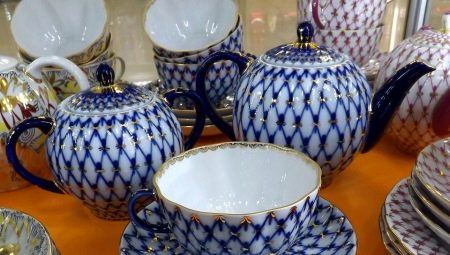There are many beautiful drawings on porcelain, but the most popular was and remains the cobalt grid pattern, which conquered many art lovers. Such dishes can be used for special occasions or simply put in a prominent place to decorate the interior.
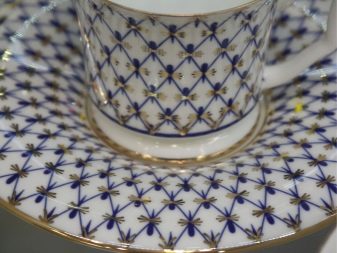
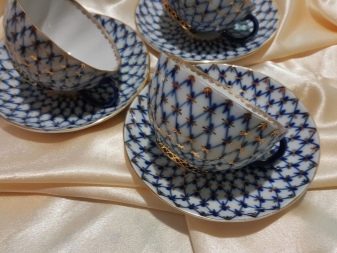
A bit of history
This pattern first appeared in 1945, after which it began to be used as a classic version of the pattern on products Lomonosov porcelain factory. It was at this factory that the master who invented this pattern worked, but at the very beginning it was made in a completely different color - gold. The “cobalt grid”, familiar to us, was invented by the famous artist of those times Anna Yatskevich. She came to the factory after an internship and began to work at the newly opened art laboratory.
Porcelain dishes at the Lomonosov porcelain factory began to be produced immediately after the war. And only in 1946, the artist created and put on display the net is no longer gold, namely cobalt. This is how you need to have patience to manually start painting porcelain with a brush! At first glance, it might seem that it is an ordinary geometric pattern, unremarkable, but at the same time beautiful and austere.
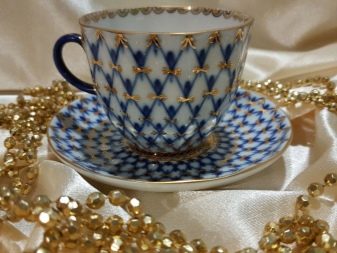
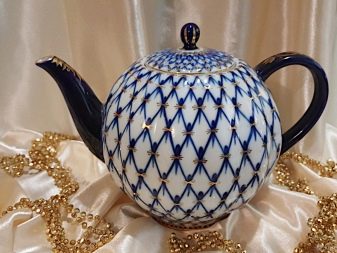
This pattern was painted tea set made by Serafima Yakovleva in the form of a tulip, and it was he who inspired Anna to create a unique masterpiece.
A few years later this drawing became famous all over the world: an exhibition was held in Brussels, it was there that the LFZ (Lomonosov Porcelain Factory) exhibited its beautiful pieces, and among them - services with a mesh pattern.Of course, the plant did not strive for fame and recognition, but simply wanted to show what products it produces and in what quantity. But for the service of Anna Yatskevich, the plant received its award, although the service was not prepared as an exhibit, because it had already been made long before that.
Unfortunately, the artist did not live up to that time and did not find out that her author’s pattern became popular all over the world. Although after her there were a lot of beautiful patterns on porcelain, but this one brought her the greatest fame. Also, all the products of that time had another feature - the individual signature of the artist, nowadays they simply put a seal with her initials.
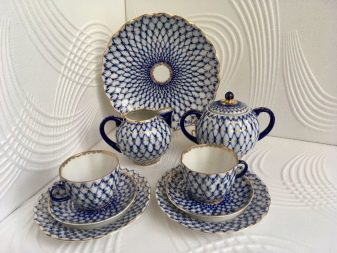
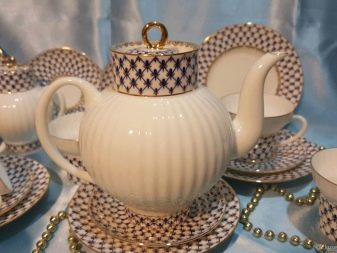
The appearance of the pattern
There are several versions. In the first case, Yatskevich took the “Own” service as the basis, which was made by special order for the Empress Elizabeth.
According to the second version, Anna lived all her life in the besieged Leningrad, she studied at the art school and went to work at the factory. Quite often I saw how the searchlights converge at night, and maybe even the glass covered with white paper prompted her to create such a picture. And that is how the first original pattern appeared on porcelain dishes.
But already in the modern world, experts made comparisons of these two figures, and found that there is practically no similarity here, since the “cobalt grid” was made underglaze cobalt, and the pattern was interesting and unique.
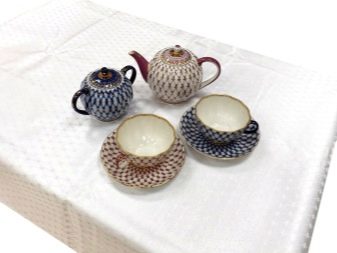

Also, if you look closely, the intersections of the lines in the figure are decorated with gold stars, and on the “Own” service there are small pink flowers.
It is her drawing that is the symbol of all Russian porcelain.
There is another feature here - it is a pencil for painting, it may have been ordinary, but porcelain paint was used instead of the core. The manufacturer of this pencil was the factory "Sacco and Vanzetti."
None of the artists of the plant liked this pencil, and Yatskevich chose it and painted her first service. This pencil was uneven, and the drawing lay in a wave, but subsequently they began to use paints. And today, special hollows are knocked out on the dishes and paint is already applied on them. And until now, it is the first painted service that has been preserved and is located as an exhibit in the Russian Museum.
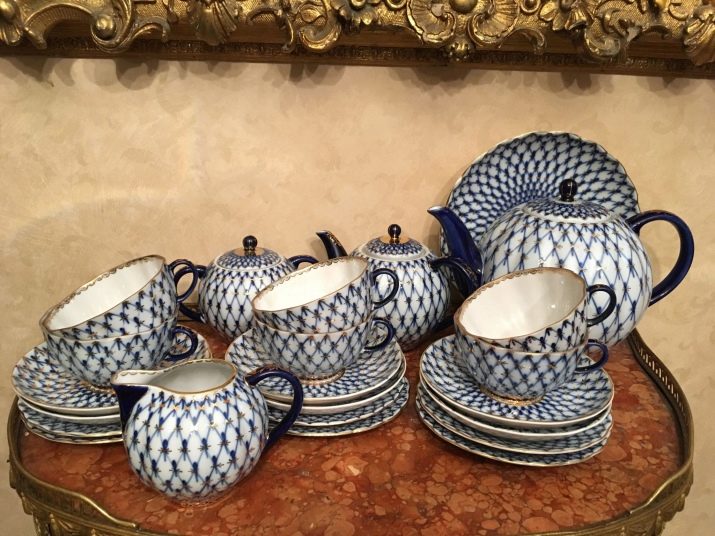
After that, at the LFZ and IFZ (Imperial Porcelain Factory), all appliances and utensils: coffee sets, cups, vases and much more began to be decorated with a “cobalt grid”.
Imperial Porcelain Factory
The Imperial Factory was founded in 1744 in St. Petersburg - then it was the only factory that engaged in the production of porcelain. It was there that dishes were made for Catherine the Great, and a tea set was made, the dish of which had a monogram of Count Grigory Orlov. Production could withstand the difficult post-war times, along with it you can put the Vinogradov factory, which also produces porcelain.
At IFZ, a set of dishes “a cup with a lid and a saucer”, designed for the wife of Paul I, was released; it was the only one available; they did not produce such sets anymore. In the heyday of the era of the XIX century, the plant began to produce services for the Romanov family.

Of course, the imperial factory made more frequent deliveries of its products to imperial families.
Today, IFZ makes fine porcelain, it includes porcelain services, various figurines, and it is in this production that bone china is made, which is nowhere else in the world. All products are painted and painted by hand, after which they are coated with gold plating. There is also its own seal, which symbolizes that the product is not a fake, but real Lomonosov porcelain, and it cannot be confused with any other.
Today you can even find glass goblets with a cobalt mesh pattern on it.

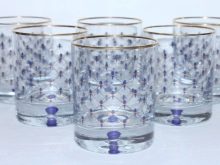

Bone china
Such porcelain can be called royal; it is engaged in its production Imperial factory. It is a thin material, rings perfectly and has a perfectly white color. They call him bone because of the burnt meal of cattle bones included in its composition.
Bone china is used to make tea sets, coffee sets, all kinds of figurines and much more.
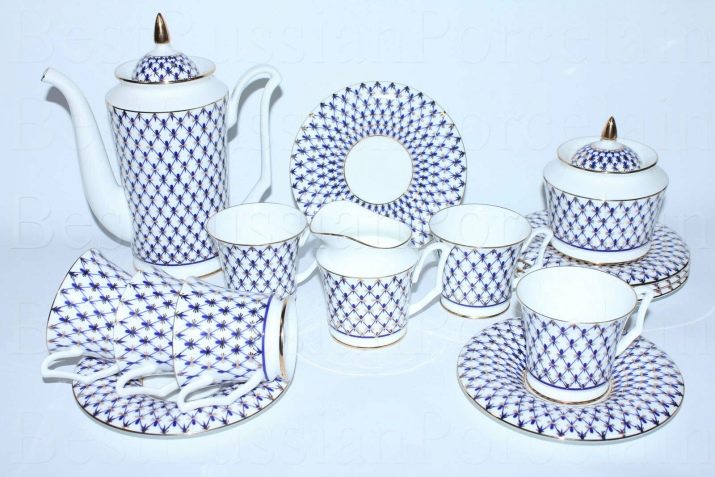
All work on the production of products takes place almost manually, pens for mugs and other small products are assembled and glued together by the hands of craftsmen. Drawing on products is also applied manually, with the exception of some points when using a spray gun. Products such as plates, saucers are made by pressing the material and then firing it.
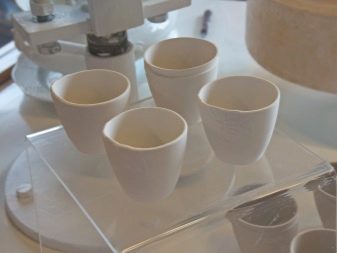

Pattern nowadays
Today, this blue-gold pattern does not lose its popularity. But only Lomonosov porcelain factory has the rights to such porcelain and products from it. This tableware is used for ceremonial meetings and tea parties, and, for example, a vase for napkins will look great on the table as a decoration.
Real connoisseurs of art can be found in the collection of coffee pots, hand-painted teapots, because this painting is famous all over the world.
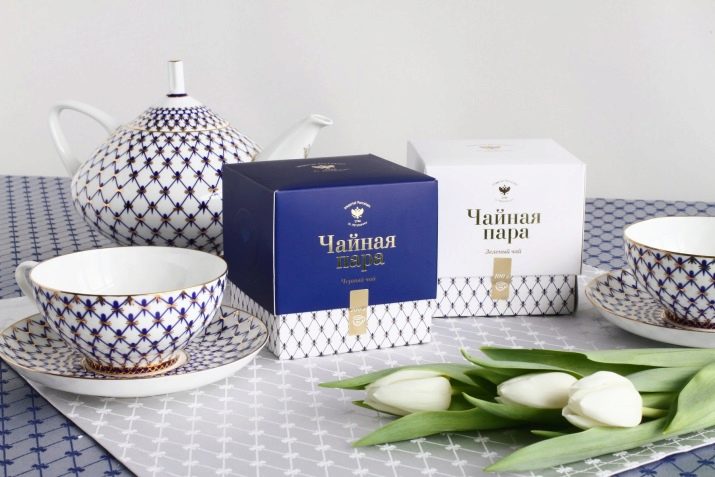
The factory produces not only exclusive services, plates and utensils, but also manufactures products for everyday use. The products of the Lomonosov plant are exhibited at all international exhibitions abroad, famous objects are stored in museums around the world. Several well-known auctions are fighting for the right to possess the products of this plant.
See below for more details.
